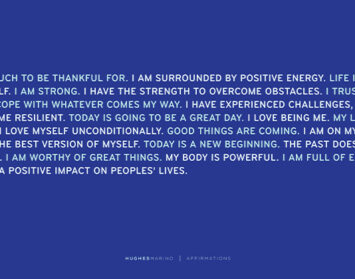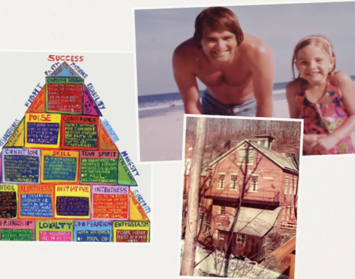
People say they “raised” a family, yet they “built” a business. Raising a successful family, however, isn’t all that different from raising a successful company. Both require a tremendous amount of love, devotion, and time – not to mention money. Some people may disagree with me, but those who are willing to make the comparison will find that successful families and successful companies have a lot of the same ingredients. When done right, most businesses could benefit from a healthy dose of family values and family rituals being injected into their corporate world, and many leading business authors agree.
Family structure is the most successful form of organization in the world.
Even the largest companies in the world like Google and Apple work in small “family-sized” groups for optimum productivity. In a recent Forbes article entitled “Teams Matter,” author Rich Karlgaard says that the “real trick to managing large teams of people is to break them down. Don’t think big; think small. Really small. Imagine your large team as Lego blocks of two, three, four and five – microteams no bigger than rock bands or basketball teams.” Or a family of five, perhaps?
Karlgaard gives numerous examples of companies that operate like families, including Apple’s late Steve Jobs, who insisted that Apple, throughout its rapid growth years, work in small groups; from 1997 through 2011, Jobs himself was part of a core trio, including Tim Cook in operations and Jony Ive as chief designer. The same theory worked for Google, when its founders Sergey Brin and Larry Page brought in mentor, Eric Schmidt, to round out their threesome. For optimum performance, companies operate best in small, family-size groups, where the small numbers help teams streamline communication, stay focused on the goals at hand, and balance out the strengths of each team member.
Families share the same values.
In his book, Tribal Leadership: Leveraging Natural Groups to Build a Thriving Organization, Dave Logan talks about the need for teams, much like families, to focus on shared values and goals in order to achieve success. Take a family’s goals for instance. Do families want one child to succeed and not the others, or do they want the entire family to be happy, healthy, and successful? Much like a family, Logan declares that successful teams and organizations can only deliver great results by focusing on shared values and goals, rather than individual successes and failures.
Logan adds, “Tribal leaders need to keep digging until they find the values that can turn a group of professionals into a family. A company is only as strong as the culture of its tribe.” Not only defining core values, but living these values on a daily basis, is a commonality among today’s most successful companies. David Kelley, founder and chairman of leading tech design firm, IDEO, adds, “When you get a good culture going, it’s hard to ruin it. When you get a bad culture, it’s hard to fix.”
Families are there for you when you need them.
As companies grow, just as families do, there are always challenges. Growth causes shifting of responsibilities, growing demands on schedules, and needing to help out to ensure the important things get done even when it doesn’t fall into your usual job description. You can always count on family, and successful teams know that they can always count on each other too. Working in small teams breeds team work, accountability, and camaraderie, much like a family, where everyone is willing to wear multiple hats to help each other out and get the job done. People don’t feel the same obligation to one another when they are working in larger groups and the impact isn’t as great if they don’t come through for the team.
My family members are my best friends.
Many coworkers dread the annual holiday party they feel obligated to attend, where people awkwardly stand around making small talk, eating tasteless hors d’oeuvres, hoping they can make a furtive early exit without anyone noticing. But if done right, social events outside of the office can be one of the leading contributors to why successful teams are just that. Go on a company ski trip or have a company cooking class on a Saturday night and you’ve got yourself one of the key elements to a successful team: “have a best friend at work.”
According to the Gallup Business Journal, having a best friend at work is one of the twelve essential elements that predict workgroup performance, along with “someone at work seems to care about me as a person.” Care about you – at work? Sounds a bit like a family, doesn’t it? Take a look at a few more on the list: receiving recognition or praise; there is someone who encourages my development; and my opinions count. All are key ingredients for developing fully engaged employees, and it’s no coincidence that they are all things happy families practice too.
Family members bring their strengths to the kitchen table.
Whether it be a traditional family, where one parent is the bread winner and one is the home maker, or a family where parents divvy up and share in financial and household responsibilities, families operate best when they are comprised of parents who bring their respective strengths to the kitchen table for the collective good of the family. In his book, Strengths Based Leadership, Tom Rath talks about the four domains of leadership strength and the need for companies, like parents, to have diverse talents and strengths. He says, “Instead of having one dominant leader who tries to do everything or individuals who all have similar strengths, contributions from all four domains lead to a strong and cohesive team. Although individuals need not be well-rounded, teams should be.”
Families that share meals together stay together.
Sometimes it really is the simple things that matter, and statistically, it is proven that families that eat dinner together stay together. What if you applied that same theory to a business? Many companies have done that and as a result, have an engaged, happier team. Whether it’s the inviting family style farm tables and kitchen in our company headquarters that look like they were extracted from the pages of Traditional Home magazine, or Jack in the Box’s coveted frozen yogurt machine they installed in their corporate office’s employee cafeteria, giving your team a place to come together and enjoy meals with one another on a daily basis is one of the easiest ways to build morale. After all, we all need to eat, so why not make it a team-building experience that positively impacts your company’s culture every day? I’m convinced that the company that eats together stays together too.
A little motherly TLC can go a long way.
When I first joined my husband’s company years ago, I couldn’t help but bring my maternal instinct with me as a mother of three nearly adult children at the time. While I wasn’t totally comfortable with it at first, it wasn’t until one of the wives on our team told me that “things have really changed around here for the better since you came along” that I recognized a little dose of my motherly TLC was in fact a good thing for companies, just as it is when it comes to raising a family.
Our company culture has transformed over the years, in large part because of some simple yet powerful practices we have implemented in raising our own family. After seeing the effects of family-infused management first hand – and in a predominantly male industry mind you – it is clear that businesses have a lot to gain by embracing the family spirit. In fact, “Embracing the family spirit” is one of our team’s ten core values, and we actually do embrace it on a regular basis. We share meals together in the office every day. We laugh at our family snapshots that flash across a slideshow playing continually in our company’s “living room.” We make time in and out of the office with our teammates and their extended families to enjoy the journey together.
If we are going to spend a good portion of our life at work, we should all try to have fun doing it. In the end, money might not be able to buy happiness, but raising a great business can.
Shay Hughes is president & COO of Hughes Marino, an award-winning commercial real estate company specializing in tenant representation and building purchases with offices across the nation. Shay writes about business leadership and company culture on her blog, Lead from Within. Contact Shay at 1-844-662-6635 or shay.hughes@hughesmarino.com to learn more.










